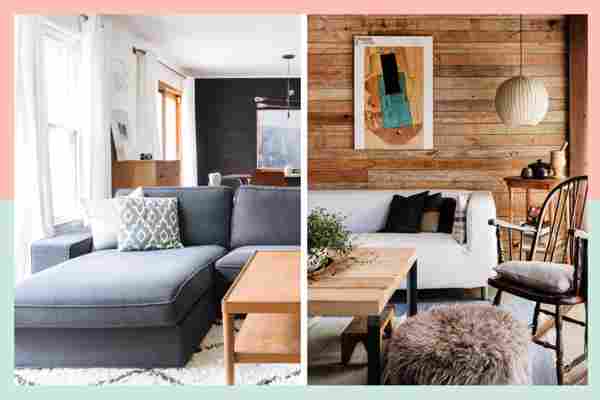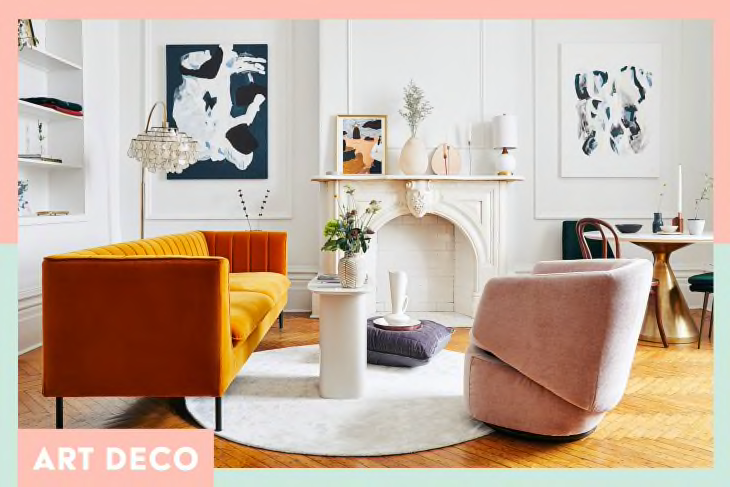
We’re going to level with you, being a design enthusiast is hard stuff. Not only do you need keep up with the latest trends and have an encyclopedic knowledge of all the colors of the year, but you should also know the differences between all the biggest design styles.
Sounds easy, right? Well, not quite. Truth is, knowing every single nuance between two different styles is easier said than done. After all, who really knows the difference between Scandinavian and minimalism? Traditional and transitional? If we’re being totally honest, even we get confused every now and then. So, to help, we’re breaking down some of the biggest styles out there.
It’s worth mentioning that everyone’s definition might differ a little bit. After all, beauty is in the eye of the beholder. But we hope the explainers below will help you appreciate the nuances of interior design.

Art Deco
Wanting to live the lap of luxury? You’re going to love art deco. Short for “Arts Décoratifs,” the style was all the rage in the 1920s to 1930s—and placed a heavy emphasis on all things glamorous: Rich colors, metallics, and, sure, the occasional animal print. But while Art Deco doesn’t shy away from being extra, it’s commonly known for its bold, geometric shapes with sharp edges. So the next time you see a picture of the Chrysler Building—or even a cool, sunburst mirror (they were huge back then)—you can thank Art Deco for making these timeless marvels.
Bohemian
While the word “bohemian” is often associated with an artful and unconventional person, the interior design style has recently become more mainstream. But when it comes to infusing a bohemian spirit in your own home, throw out the rulebook and focus on creating a relaxing space that’s personal to you. Layer your bed with throw blankets from your local vintage shop. Take Grandma’s accent chair out of storage. Create a soulful shelfie with all the trinkets you purchased on your recent trip to Africa. It’s all about creating a chill space that’s packed with personality.
Every bohemian space is bound to be different, but most of them generally focus on worn-in textiles as well as vintage furniture and accessories.
Coastal
ICYMI, coastal is all blues, whites, and anchor motifs (a.k.a. nautical); it’s not like living inside a Lily Pulitzer store (a.k.a preppy), either. When we hear the word “coastal,” we can’t help but think of the oceanfront home in “Grace & Frankie.” It’s inspired by natural elements. So while you may see a vase full of seashells, a driftwood coffee table, or a color palette of soothing blues, it doesn’t have to be as literal as you’d think.
Contemporary
Is it just us, or is practically every home considered “contemporary?” Well, that’s because a lot of them are. You see, the contemporary design style is ever-changing because it’s all about what’s in at the moment. For example, if pewter and gunmetal hardware is trending, it’s likely going to be considered contemporary.
That being said, there’s more to a contemporary home than trends. Interior designer Kita Marie Williams once told us the contemporary style aims to create a fashionable space without any superfluous fripperies.
Eclectic
Some say that opposites attract and no style better supports that theory than eclectic design. At first glance, you might think that eclecticism is super similar to bohemian. Anything goes! In reality, eclectic design is more associated with bringing two, very different designs together. Want to mix traditionalism with Scandinavian style? What about minimalism with farmhouse? Eclecticism offers a blank slate to make all your wildest design dreams come true.
Psst… want to add an eclectic energy to your space? Check out our tips for stealthily mixing different design tastes.
Farmhouse
No, farmhouse isn’t all chicken-themed decor and fruit basket paintings. While the farmhouse style certainly veers more into traditionalism, it’s really all about creating a warm, cozy space. Common characteristics include light, airy spaces, wooden accessories, and exposed beams, and cushy couches. Translation? Pretty much the shining definition of Chip and Joanna Gaines.
But just because you’re interested in farmhouse style doesn’t mean you have to take design cues from Old MacDonald. While many design lovers have leaned into the rustic aesthetic, others are giving this style a makeover with modern touches… here’s how !
Industrial
As the saying goes, one man’s trash is another man’s treasure. When industrial design was born in the 1700s, it was a purely utilitarian style that would outfit the growing factories. While industrialist design occasionally evolved to keep up with new safety regulations, it wasn’t until the ’60s and ’70s that people started to convert abandoned factories into lofts, restaurants, and hip hotels.
While industrialism features pared-down materials like wood and brick, you can also expect to find sturdy iron and steel. To play off the masculine materials, many industrial homes feature a cooler, neutral color palette. Does Dan Humphrey’s loft in “Gossip Girl” ring any bells?
Maximalist
Think more is more? Well, you’re going to love maximalism. A far cry from modernism or Scandinavian style, maximalism dares design enthusiasts to be bold. Similar to bohemian, you have the autonomy to make your space as maximalist as you’d like. Start off slow with a controlled, symmetrical maximalist à la Wes Anderson or channel your inner Austin Powers by dialing up the patterns, colors, and textures.
Mid-Century Modern
We’re not going to sugarcoat it for you: You’d have to be living underneath a rock to not know what mid-century modern is. Rising to prominence after World War II along with tract houses, mid-century modern style is a cool, pared-down alternative to the ornate pieces of yesteryear. It’s been over 50 years since the style first hit the design scene, and it’s showing no signs of losing its luster any time soon. In fact, its simple, boxy silhouette is almost more popular than ever before.
If you want to learn more about mid-century modernism, check out our crash course on the style’s most iconic pieces .
Minimalist
We hate to be the bearer of bad news, but minimalism technically isn’t an interior design style. It’s easy to associate it with a neutral color palette, airy layout, and scarce details, but we were once told the phrase simply represents making your home less, well, extra. So technically, you could have a coastal or bohemian home that is also minimalist.
Modern
Rumor has it modernism and mid-century modernism aren’t as different as you’d think. While modernism came before minimalism and contemporary design, most of the pieces we consider modern—you know, simple shapes and muted hues—generally nod back to mid-century modern style.
Rustic
So farmhouse and rustic are exactly the same, right? Think again. While the two styles share some similarities, many believe rustic is a little rougher around the edges. Here, you’re bound to see rugged, unfinished woods like alder and hickory as well as distressed chairs, fabrics, and other accessories. It’s like farmhouse style’s outdoorsy cousin.
Scandinavian
If you say you have a minimalist home, what you might mean is you have a Scandinavian home . Made popular in the 1950s by the three Scandinavian countries, Denmark, Norway, and Sweden, this style emphasizes a minimalist aesthetic, a clean color palette (perhaps with the occasional pop of color), and functionality above all else.
Fortunately, you can embrace a Scandinavian aesthetic on any continent. But before you do, check out our 10 commandments for mastering this style .
Shabby Chic
Interested in the bohemian aesthetic, but don’t want to go all out? Give shabby chic a try. By definition, the style hits on a lot of the same elements as bohemian (think: prints and distressed materials) but is paired with more put-together pieces. Go ahead, embrace shabby chic by mixing grandma’s old quilt and a sleek, mid-century side table together.
Traditional
Traditionalism might be the OG style of interior design, but don’t write it off as “dusty” or “boring.” While the style draws a lot of inspiration from the past with rich colors, beautiful prints, and ornate details, there’s plenty of room to add some modern touches. Simultaneously elegant and cozy, traditional homes often integrate pieces from different eras and places (think baroque chairs with beautiful chinoiserie vases) in a clean, composed manner.
Transitional
Torn between modernism and traditionalism? Well, thanks to transitional style, you don’t have to choose. If you ask us, traditionalism is like the best of both worlds: It focuses on a minimalist aesthetic and a muted color palette of grays, tans, and off-whites, but celebrates texture. As for the furniture? You can expect a mix of pieces with curved and straight lines.
What other design terms do you want us to define? Let us know in the comments below!
